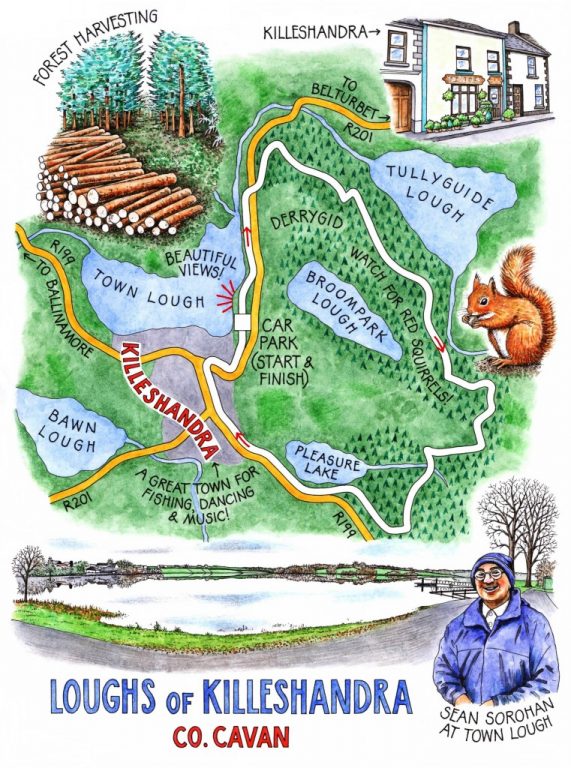
Irish Independent – WALK OF THE WEEK – Christopher Somerville
6 February 2010
45. Loughs of Killeshandra, Co. Cavan
If you chucked a stone into Monaghan it would bounce off a drumlin, and if you hurled a pebble into Cavan it would plop into a lough. How many little eye-like lakes wink in the mild green face of Cavan? No-one’s counting. Half a dozen of the most beautiful encircle Killeshandra, though to walkers most appear only as a hint of a twinkle between the pine and spruce trunks. But Town Lough lay broad and open under a blank winter sky, with crow’s-feet of ice crinkling its corners, as Jane and I walked its shore with Sean Sorohan.
Quietly spoken and gently humorous, Sean is chairman of Killeshandra’s Community Council. He worked with friends and colleagues for fifteen years to establish a waymarked route that would open up some of the local landscape to walkers. But it was when Coillte opened a way through their forest between Tullyguide and Broompark Loughs that things really came together. Now people of all ages and abilities can follow the Killeshandra Loop walk from the neat little County Cavan market town out into the lake-pocked countryside that lies on its doorstep.
Yesterday’s thick fog had partially dispersed, leaving a pale and dreamy light to drift over water and under clouds. ‘I’m a farmer these days,’ Sean mused as we climbed the track into the forest-smothered townland of Derrygid. ‘That gives you plenty of exercise, all right! I was forking silage for the calves this morning, with a proper old pitchfork. It gives you something to get out of bed for.’
One of Coillte’s harvesting machines lurched roaring up a pitch-dark alley between the ranks of firs, twin lights burning like dragon eyes either side of a fearsome pair of articulated jaws. As we watched, the monster swivelled ninety degrees, reached in among the trees and plucked out a whole fir as a dentist draws a tooth. It spun and crushed it with a great crackling of bark and twigs, shook it onto a pile of uprooted trees, and reached back into the forest to grip and snatch another.
The talking slid by, easily and naturally, as walking talking always does. ‘You’d the slean turf, higher up in the bank,’ Sean expounded on cutting turf as a boy on the family farm a dozen miles from Killeshandra, ‘and then the mud turf, lower down and more decayed. You’d mix that mud turf with water and spread it six inches thick on the bank. You made rows in it with the sides of your hands as you walked backwards, and then you cut across them to form the sods. When the sun dried it you could lift the sods with a spade. It actually burned better than slean-cut turf – it was denser. But that’s a skill that’s all gone now.’
Sean has spotted red squirrels in the wood around Killeshandra. They owe their revival to an increase in numbers of pine marten, who prey on the introduced grey squirrels that are pushing out the native reds all over the country. In 1911 six pairs of greys were released at Castle Forbes in County Longford, as an interesting addition to the local fauna. In the ensuing century their offspring have colonised most of the country north and east of the Shannon. How wonderful if the Killeshandra woods were to prove a springboard for a comeback by the reds.
From Coillte’s conifer woods we took to quiet country lanes between acres of rolling parkland studded with fine specimen trees. Down along the Pleasure Lake we went, and back through the outskirts of Killeshandra where a man stood hoovering his car ramp, his cloth cap stuck all over with fishing flies. ‘Killeshandra’s a fishing town,’ Sean remarked with pride, ‘and a singing and dancing one too. Oh, great for the music, now!’
Walking down the road Sean gave us a lick of ‘Ballyconnell Fair’, and we returned the compliment with a stave of ‘Kate From Ballinamore’. That great border singer Cathal McConnell speaks of traditional music as ‘music that tastes of itself’. Well, Killeshandra is a town and a countryside that tastes of itself, and it’s all the better for that.
WAY TO GO
MAP: OS of Ireland 1:50,000 Discovery 34; downloadable map/instructions (highly recommended) at www.discoverireland.ie/walking.
TRAVEL:
Rail (www.irishrail.ie):
Bus (www.buseireann.ie): 465 from Cavan (Tues only)
Road: R207 from Belturbet, R199 from Ballinamore, R201 from Carrick-on-Shannon. Town Lough car park (‘Killeshandra Woodland Walk’ brown sign) off Belturbet road on edge of Killeshandra.
WALK DIRECTIONS: Pass ‘Loop Walks’ sign; follow purple arrows (PA) beside Town Lough. In ¼ miles, right up bank, left along R207 pavement. In 200 m, cross road; follow forest track (PA) for over 2 miles to road. Right (PA) for ¾ mile, then right into forest (PA) for ½ mile to road. Right; cross road at picnic place; continue into Killeshandra. At foot of town, right (‘Belturbet’) to Town Lough car park.
LENGTH: 5½ miles: allow 2 hours
GRADE: Easy
DON’T MISS … !
• the beauties of Town Lough and Pleasure Lake
• red squirrels in the woods (keep your eyes peeled!)
• c
REFRESHMENTS: Plenty of places in Killeshandra
ACCOMMODATION: Ethel and Donald Woodhouse, Glencloy House, Drumgoon, Killeshandra (049-433-4315) – wonderful, warm and friendly house
INFORMATION: Walking tour operators, local walks including Discover Ireland’s National Loop Walks, walking festivals throughout Ireland: www.discoverireland.ie/walking; www.coillteoutdoors.ie
INFORMATION:
Cavan Tourist Office: Farnham Street, Cavan (049-433-1942; www.cavantourism.com)
csomerville@independent.ie